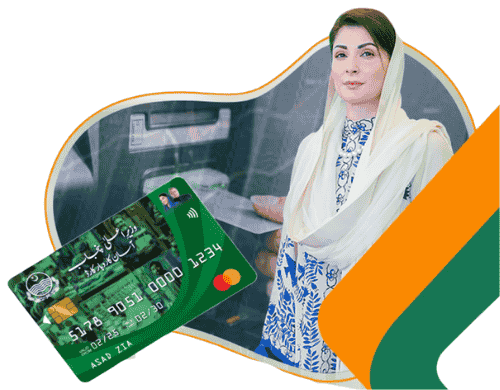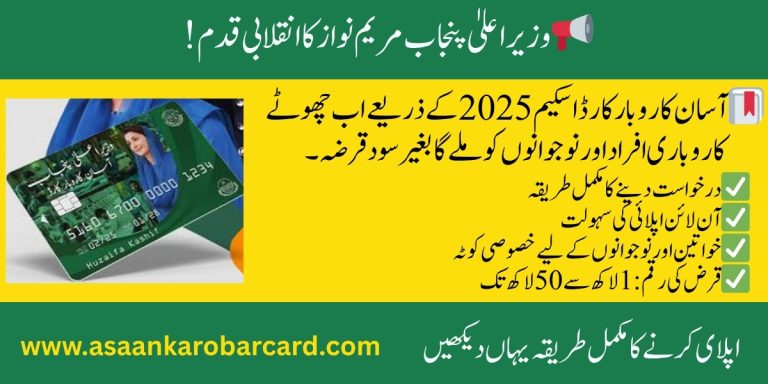Breaking: Asaan Card to Be Linked With National ID for Easy Access 2025
The Government of Pakistan has announced a Breaking: Asaan Card to Be Linked With National ID for Easy Access, offering citizens simple registration, transparency, and direct welfare benefits This major step is part of the government’s ongoing mission to simplify financial inclusion, digital verification, and transparency in welfare schemes. By merging the Asaan Card scheme with the CNIC, millions of citizens will now enjoy easier access to subsidies, healthcare benefits, education support, and digital financial services.
This integration means that citizens will no longer need separate registrations or multiple documents to avail government programs. Instead, the CNIC , already recognized as the universal identity in Pakistan , will serve as the gateway for activating and using the Asaan Card. It is not only a convenience measure but also a way to strengthen Pakistan’s digital governance structure.
The decision to link Asaan Card with National ID (CNIC) was taken to reduce fraud, eliminate ghost beneficiaries, and make sure that subsidies and benefits directly reach deserving people. From bill payments and healthcare assistance to loans and education aid, this integration ensures that one card can open doors to multiple opportunities.
In the modern era of e-governance, smart card technology, and digital identity, Pakistan is following the path of countries like India and Bangladesh where ID-linked welfare programs have already shown success. Citizens can expect more secure, transparent, and fast access to services , truly making governance simple and citizen-friendly.

Key Highlights at a Glance
| Feature / Update | Details |
|---|---|
| Breaking News | Breaking: Asaan Card to Be Linked With National ID for Easy Access |
| Purpose | Easy access to subsidies, welfare schemes, healthcare, education, and financial inclusion |
| Integration Authority | NADRA managing database and biometric verification |
| Registration Methods | Offline via centers & Online via official portals |
| Fraud Prevention | CNIC verification reduces duplication and misuse |
| Main Beneficiaries | Low-income families, students, patients, farmers, and unemployed citizens |
| Future Outlook | Expansion to digital wallets, mobile banking, and e-governance services |
What is Asaan Card Scheme
The Asaan Card is a welfare and financial support initiative designed to make essential services more accessible. It is meant for citizens who often struggle with long procedures and documentation in order to receive subsidies or government aid. By introducing this card, the government is aiming to create a single platform that provides relief, assistance, and financial access under one umbrella.
Originally, the Asaan Card scheme was introduced as part of poverty alleviation and social welfare programs. It was especially helpful for low-income families, unemployed citizens, and those needing quick access to healthcare and education support. Through subsidies and financial inclusion efforts, the card offered direct benefits to people without involving middlemen.
Now, Breaking: Asaan Card to Be Linked With National ID for Easy Access, its credibility and reach are expected to multiply. Citizens can trust that their identity will be securely verified, and benefits will reach them directly without delays or fraud.
Why the Government Is Linking Asaan Card with National ID
The government’s decision comes from the need for transparency and ease. Welfare programs in the past often faced challenges such as duplication of beneficiaries, fake registrations, and unequal distribution of funds. By linking Asaan Card with National ID (CNIC), these loopholes can be closed.
This move will also ensure that every citizen is identified through NADRA’s biometric verification system, reducing errors and misuse. In addition, it will allow faster integration with banks, digital wallets, and other financial services, creating a one-stop solution for citizens.
Finally, this step is in line with Pakistan’s broader vision of digital transformation and e-governance. Just as CNIC has become the key to accessing SIM cards, bank accounts, and other official services, linking the Asaan Card to it will establish a strong, future-ready welfare infrastructure.
How National ID Integration Will Simplify Access
The biggest advantage of this integration is easy access. Instead of applying separately for each scheme, citizens can now use their CNIC to activate their Asaan Card and unlock all benefits linked to it.
This simplifies the process for low-income families, rural residents, and people unfamiliar with complex procedures. It also ensures that benefits are directly deposited into the right accounts or linked wallets, saving time and reducing hassle.
With a single identity (CNIC), citizens can:
- Receive subsidies on food and utilities
- Access healthcare and medicine support
- Apply for education programs
- Avail microfinance and small loans
- Pay bills and government fees easily
Key Features of the Asaan Card–National ID Link
The integration brings a number of strong features that will directly benefit citizens and make the system more transparent, secure, and user-friendly:
- Universal Access – CNIC becomes the single ID to access multiple services.
- Biometric Verification – Secure identity through NADRA’s advanced system.
- Digital Wallet Integration – Asaan Card can be connected with mobile wallets and banking apps.
- Transparency – Subsidies and welfare funds distributed directly without middlemen.
- E-Governance Expansion – Access to government services like tax payments, fee submissions, and health records.
- Fraud Prevention – Elimination of fake registrations and duplicate beneficiaries.
- Direct Bank Transfers – Subsidies, scholarships, and loans can be transferred straight into linked bank accounts.
- Utility Bill Payments – Citizens can easily pay electricity, gas, and water bills through the card.
- Healthcare & Education Support – Direct coverage for medical expenses and school/university fees.
- Nationwide Usability – Cards will be recognized across Pakistan with online and offline support.
These features represent a major step toward a smart card technology system in Pakistan, bringing together welfare, financial inclusion, and digital governance under one umbrella.
Eligibility Criteria for Linked Asaan Cards
Not every citizen will automatically qualify for benefits through the Asaan Card. The government has set eligibility requirements to ensure that the benefits reach those who need them most.
- Low-income households registered under social welfare databases
- Families already enrolled in government subsidy programs
- Citizens verified by NADRA with a valid CNIC
- Students, patients, and unemployed individuals who fall under defined income thresholds
By applying these criteria, the government can focus on poverty alleviation and fair distribution of resources.
Registration Process After Integration with CNIC
The registration process will become simpler after CNIC integration. Citizens will only need to provide their National ID number, and NADRA’s database will handle verification automatically.
Previously, applicants had to go through multiple forms and separate verifications for each welfare program. Now, the Asaan Card will work as a single registration gateway, making the process efficient and user-friendly.
This Breaking: Asaan Card to Be Linked With National ID for Easy Accessalso ensures real-time checks against duplication and fraud, giving applicants peace of mind that their benefits are secure.
Step-by-Step Guide to Activate Linked Asaan Card
Activating your linked Asaan Card is straightforward:
- Provide your CNIC number at the registration point or online portal.
- Biometric verification through NADRA will confirm your identity.
- Once approved, the card will be linked to your CNIC and activated.
- You will receive confirmation via SMS or email.
- The card can then be used for subsidies, bill payments, and financial access.
This activation ensures that every citizen can benefit from the program with minimum paperwork.
Documents Required for Linking Asaan Card to National ID
To successfully link your Asaan Card with the National ID (CNIC), a few essential documents are required. These documents serve as proof of identity, residence, and eligibility, ensuring that benefits reach genuine citizens and not those trying to misuse the scheme. Keeping the paperwork ready before applying will save time and prevent unnecessary delays.
The most important document is the Computerized National Identity Card (CNIC) issued by NADRA, as it forms the foundation of this integration. Along with it, citizens may need to provide proof of residence, such as a utility bill or official address registration, to confirm their location. For those applying for subsidies, healthcare benefits, or financial support, a proof of income certificate or salary slip may also be required to establish eligibility. Additionally, passport-size photographs are often requested for records and card printing purposes.
Having these documents organized in advance will make the registration process smoother, whether you choose to apply online or offline. The government has emphasized that only genuine and verified documents will be accepted, so applicants should double-check their details before submission. This careful approach ensures that welfare programs remain transparent and efficient, reaching the families who need them most.
How Citizens Can Verify Their Asaan Card with CNIC Online
One of the most convenient updates in this program is the option to verify your Asaan Card online using your CNIC. Instead of standing in long queues at government offices, citizens will now be able to check their status with just a few clicks. This step is particularly useful for people living in rural areas or those with busy schedules who cannot spare the time to visit verification centers.
To verify the card, citizens will simply need to visit the official government or NADRA portal and enter their CNIC number in the verification field. The system will then instantly confirm whether the Asaan Card has been linked, activated, or is still under process. In addition to card status, the online system may also display eligibility details, such as whether the citizen qualifies for subsidies, healthcare benefits, or education support.
This online process not only saves time but also adds an extra layer of transparency and accountability. With digital records, citizens can be assured that their details are safe and their eligibility is properly recorded. For those who do not have internet access, SMS-based services will also be provided, making the verification process accessible to everyone across Pakistan.
Role of NADRA in the Asaan Card–National ID Integration
The National Database and Registration Authority (NADRA) is at the heart of the entire Asaan Card integration process. As Pakistan’s central authority for issuing CNICs and maintaining citizens’ digital identities, NADRA’s role is to ensure that every cardholder is verified through its advanced biometric system. This guarantees that only authentic citizens benefit from the government’s welfare schemes.
NADRA will maintain and update the national beneficiary database, cross-checking records to prevent duplication and fraud. Its system will also be responsible for handling biometric authentication, ensuring that subsidies and financial support are distributed to the right individuals. In addition, NADRA will manage the online verification portals, SMS services, and mobile applications that make the process convenient and accessible.
Without NADRA’s expertise in digital identity management, such a large-scale welfare program would not be possible. By leveraging its secure systems and advanced technology, NADRA is helping Pakistan move toward e-governance, transparency, and digital inclusion, ensuring that no deserving citizen is left behind.
How the Link Will Prevent Fraud and Misuse
Fraud and misuse have long been challenges in welfare and subsidy programs. In the past, fake registrations, duplicate entries, and ghost beneficiaries drained resources that were meant for the poor and needy. By linking the Asaan Card directly to the CNIC, the government is creating a foolproof system where such practices will be nearly impossible.
Every citizen’s data will be verified against NADRA’s biometric database, which uses fingerprints and other details to confirm identity. This means no one can register multiple times or use someone else’s identity to claim benefits. Direct transfers to linked accounts will further ensure that funds are only received by verified beneficiaries.
This approach not only reduces corruption but also builds public trust in government programs. Citizens can be confident that welfare resources are reaching the right hands, while the government can monitor and track usage in real time. It is a huge step toward fairness and accountability in Pakistan’s social welfare system.
Impact of the Integration on Transparency and Fairness
The integration of the Asaan Card with the National ID is more than just a technological upgrade; it is a step toward greater transparency and fairness in welfare distribution. By using the CNIC as the central identity tool, the government ensures that only those who are genuinely eligible can access benefits. This removes any influence of favoritism or corruption.
Transparency comes from the fact that all transactions and records are digital and traceable. Every subsidy provided, loan disbursed, or healthcare expense covered can be tracked in the system, reducing the chances of misuse. Citizens also benefit from this digital trail, as they can check their own records and status whenever needed.
Fairness is another major outcome of this integration. Families across rural and urban areas will now have equal opportunities to receive subsidies and assistance without facing unnecessary hurdles. By treating every citizen equally under the CNIC system, the government is promoting justice and equality in social welfare programs.
How Families Will Benefit from Easy Card Access
Families stand to gain the most from the decision to link the Asaan Card with the National ID. Instead of going through lengthy registration processes for every program, a single CNIC-linked card will give them access to a wide range of benefits, including food subsidies, utility bill relief, healthcare coverage, and educational assistance.
For households struggling with rising living costs, the Asaan Card will act as a lifeline, providing financial relief at the right time. Children can benefit from scholarships or reduced school fees, while elderly family members can receive healthcare support without delays. Similarly, small business owners within the family can use the card to apply for micro-loans or support schemes.
Most importantly, families will no longer need to visit multiple offices or provide documents repeatedly. With one identity document serving as the key, they can access all welfare programs in a seamless way. This ease of access will not only improve their quality of life but also restore confidence in government services.
Digital Verification Process for Asaan Card Holders
The digital verification process is one of the most important improvements in the Asaan Card scheme. It allows citizens to confirm their card status, eligibility, and linked benefits without visiting physical offices. By using NADRA’s secure digital systems, the verification becomes fast, reliable, and nationwide.
Citizens can use official websites, mobile applications, or SMS services to verify their cards. For example, entering a CNIC number into the online portal will instantly display whether the card is active, under process, or eligible for new subsidies. This reduces the need for paper-based systems, long queues, and manual checks.
The digital process also ensures equal access for citizens in both urban and rural areas. Even people without smartphones can use SMS codes for verification, while those with internet access can check through mobile apps. By adopting these digital solutions, the government is moving closer to a fully e-governed Pakistan, where every citizen can access services with ease and trust.
Challenges in Linking Asaan Cards Nationwide
While the integration is promising, it comes with challenges:
- Connectivity issues in rural and remote areas.
- Awareness gap among illiterate citizens about digital processes.
- Data privacy and security concerns with centralized databases.
- Technical glitches that may delay activation.
The government will need to invest in awareness campaigns, better infrastructure, and strong cybersecurity measures to address these issues.
Benefits of Breaking: Asaan Card to Be Linked With National ID for Easy Access
The integration comes with a long list of benefits. Here are 15 key advantages:
- Easy access to subsidies
- Simplified registration process
- Direct welfare distribution
- Transparent system
- Reduction in fraud and misuse
- Financial inclusion for low-income groups
- Access to digital wallets and banking
- Support for healthcare expenses
- Aid for education and scholarships
- Better support for farmers and rural families
- Streamlined bill payments
- Stronger trust in government programs
- Time-saving and paperless process
- Alignment with Pakistan’s digital vision
- Stronger link between citizens and e-governance

Conclusion
The Breaking: Asaan Card to Be Linked With National ID for Easy Access marks a new beginning in Pakistan’s welfare and financial inclusion journey. By combining the Asaan Card with the CNIC, the government is not only simplifying processes but also ensuring that every deserving citizen receives their fair share of support.
This step reflects Pakistan’s commitment to digital identity, e-governance, and smart card technology, ensuring a transparent and fair welfare distribution system. With the active role of NADRA, this integration is expected to be smooth, secure, and highly beneficial for millions of citizens.
Frequently Asked Questions (FAQ’s)
Q1. What is the Asaan Card?
The Asaan Card is a government welfare card that provides access to subsidies, healthcare, education, and financial services.
Q2. Why is it being linked with CNIC?
Linking ensures transparency, prevents fraud, and simplifies access for all citizens.
Q3. How can I register for the linked Asaan Card?
You can register online via the official portal or offline at designated centers.
Q4. Who is eligible for this scheme?
Low-income families, students, unemployed citizens, and those enrolled in welfare programs.
Q5. How will NADRA help in this process?
NADRA will verify identities through its biometric database to ensure accuracy and prevent duplication.







